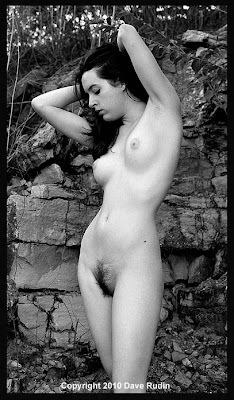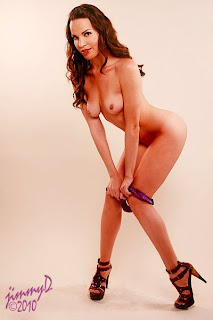
I received the new issue of B&W magazine in the mail a few days ago. This is the Single Image Contest issue that includes one of my photos, “Nude, Prince Edward Island, 2006,” that won a Bronze Award. My photo is on page 51 and can be seen above. You can see the cover below.
The issue, #80, is also available now in bookstores and on newsstands for those of you who may want to purchase a copy or just take a look.
That’s the good news. Now the bad: my photo was placed in the wrong category. The image was created as an in-camera double exposure on film, but it won third prize in the category called Digital Conceptualization. That’s right: digital! I work hard to use film and make prints in a darkroom, and pride myself on the fact that I don’t do digital, but now people will see my photo and think that it was something that I doctored up in the computer, rather than being a product of creative vision on location. That’s a real disappointment for me.
So, I wrote the following message to the magazine’s staff yesterday morning:
“Dear B&W:
I recently received my copy of issue #80, the special Single Image Contest Awards issue. As you had notified me, one of my photographs was given a Bronze Award (on page 51), and I want to  thank you again for selecting my image out of the many that were submitted. I feel honored.
thank you again for selecting my image out of the many that were submitted. I feel honored.
However, I am also writing to inform you of my great disappointment in seeing that my photo was placed in the wrong category, Digital Conceptualization. While I agree that the image is conceptual in nature, it is definitely not digital. Rather, it was made as an in-camera double exposure – something that I conceived in my mind with forethought while on location and not something that I assembled on a computer screen afterwards.
Actually, I take pride in the fact that I still use film which I develop myself and that I still make silver prints in a darkroom. The only digital work I do is to make straight scans from negatives to post on the web and to submit to competitions and publications such as yours. It is therefore quite upsetting that readers of B&W will see my photo and think that the image was something that was doctored up in a computer, which is something I would never do.
What is perhaps even more unsettling is that someone would simply assume that a photographic image is the result of digital computer manipulation without considering the alternatives or even trying to find out. Is this what photography has come to? When a fine publication such as B&W does so, it’s even worse.
You say in the contest prospectus that it makes no difference if an image was made via film or digital capture. If that is so, why only have a category for Digital Conceptualization? Why not have one for Analog (Film) Conceptualization as well? Think of the fine work that Jerry Uelsmann has done over the years using film and multiple enlargers. Think of the photographs that have been created in a darkroom using sandwiched negatives. Think of the work such as mine that were done as multiple exposures in the camera. All of these are conceptual in nature, yet none of them fall into the category of Digital Conceptualization. Is it fair that they should be excluded or wrongly labeled?
Perhaps a better solution is this: create a category that is simply called “Conceptual.” This way, it would encompass everything. Of course, people might still look at a film image and believe it was done digitally, but I much prefer that ambiguity to having somebody told outright that a photograph is the result of digital manipulation when in fact it is not.
Again, I want to tell you how pleased I am that my image was given a Bronze Award and I thank you for doing so. I just believe that your way of categorizing images could be improved and I hope you will consider what I have written. “
I wasn’t sure if I would get a response, but in fact I got two. One was from the staff of the magazine that handles the competition, and they thanked me for writing and for making suggestions for change. They wrote that they have also been thinking about the same things.
The other response was a phone call from Henry Rasmussen, the original publisher and editor of B&W magazine and now the person in charge of judging the magazine’s competitions. He left a message while I was out yesterday, but I called him back today and we had a nice discussion on the topic.
He apologized for the error and admitted that he could have been more diligent in determining the method by which my photo was made. As a film and darkroom user, I told him of my belief that for any category that is reserved for digital only, there should be one just for film users, too.
In the end, he told me that changes should be made that will hopefully prevent this type of error from happening again, so although I’m disappointed that my photo was put in the wrong category this time, I can at least have some satisfaction in knowing that I’ve helped to correct things for the future. As with my photo being selected for an award and getting published, I am happy about that.
(Now if only the producers of “Dancing With the Stars” will listen to my suggestions and come up with a system that will prevent someone like Bristol Palin from ever making it to the finals again. Until they do, I am not planning to watch.)
 Well, another year comes to a close and, along with it, the first decade of the new millennium lies behind us as well. You'll have to wait a thousand years for another 1-1-11 to come along!
Well, another year comes to a close and, along with it, the first decade of the new millennium lies behind us as well. You'll have to wait a thousand years for another 1-1-11 to come along!










 Some of the volunteers
Some of the volunteers

 That's my photo at the top. Note that somebody had placed a bid and then crossed it out!
That's my photo at the top. Note that somebody had placed a bid and then crossed it out!
 My friend Omar
My friend Omar The gorgeous photo by Lillian Bassman that I wish I could have afforded
The gorgeous photo by Lillian Bassman that I wish I could have afforded Yours truly with the buyer of my photo
Yours truly with the buyer of my photo


 Art for sale
Art for sale  A gorgeous mezzotint
A gorgeous mezzotint Another interesting print
Another interesting print John Cichowski
John Cichowski




 Lisa Benson
Lisa Benson























